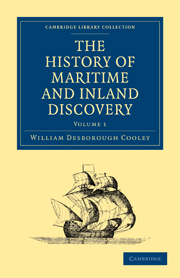Book contents
- Frontmatter
- Contents
- BOOK I GEOGRAPHY OF THE ANCIENTS
- BOOK II GEOGRAPHY OF THE MIDDLE AGES
- BOOK III PROGRESS OF GEOGRAPHY IN THE MIDDLE AGES
- CHAP. I DISCOVERIES OF THE NORTHMEN
- CHAP. II MAPS OF THE MIDDLE AGES
- CHAP. III JOURNEY OF CARPINI INTO TATARY
- CHAP. IV TRAVELS OF RUBRUQUIS
- CHAP. V TRAVELS OP MARCO POLO
- CHAP. VI TRAVELS OF MARCO POLO CONTINUED
- CHAP. VII ODERIC OF PORTENAU
- CHAP. VIII EMBASSY OF CLAVIJO
- CHAP. IX EARLY DISCOVERIES OF THE PORTUGUESE
- CHAP. X THE PASSAGE BY THE CAPE DISCOVERED
CHAP. VIII - EMBASSY OF CLAVIJO
Published online by Cambridge University Press: 05 July 2011
- Frontmatter
- Contents
- BOOK I GEOGRAPHY OF THE ANCIENTS
- BOOK II GEOGRAPHY OF THE MIDDLE AGES
- BOOK III PROGRESS OF GEOGRAPHY IN THE MIDDLE AGES
- CHAP. I DISCOVERIES OF THE NORTHMEN
- CHAP. II MAPS OF THE MIDDLE AGES
- CHAP. III JOURNEY OF CARPINI INTO TATARY
- CHAP. IV TRAVELS OF RUBRUQUIS
- CHAP. V TRAVELS OP MARCO POLO
- CHAP. VI TRAVELS OF MARCO POLO CONTINUED
- CHAP. VII ODERIC OF PORTENAU
- CHAP. VIII EMBASSY OF CLAVIJO
- CHAP. IX EARLY DISCOVERIES OF THE PORTUGUESE
- CHAP. X THE PASSAGE BY THE CAPE DISCOVERED
Summary
A disposition to indulge in the marvellous is conspicuous in the narratives of all the earliest travellers; but already in the beginning of the fifteenth century a better taste began to appear. Among the well-informed and veracious travellers of this period, the Spaniard, Ruy-Gonzales de Clavijo is the most distinguished. The fame of Timur's conquests being spread abroad through every part of Europe, induced Henry III. king of Castile to send ambassadors to the khan, with instructions to pay their respects to him in the heart of his dominions. The real object of the embassy, however, was to learn the manners and the strength of the nations inhabiting the interior of Asia, to observe the situation of the conquered, and the character of the conqueror. In consequence of this determination, two noblemen of the court, Pelajo de Sotomayor and Ferdinand de Palazuelas, set out for the Levant in 1393, arrived at the camp of Timur before his victory over Bajazet, and witnessed the total overthrow of the Turkish army. The conqueror dismissed the Spaniards loaded with presents, and sent an embassage along with them as an additional honour to the king of Castile.
The success of this first step towards a correspondence encouraged Henry to send a second embassy to Tamerlane in 1403; at the head of this was Clavijo, who returned to Spain in 1406, and wrote an account of the reception he had met with at Samarcand, and of all that he observed in the various countries through which he passed.
- Type
- Chapter
- Information
- The History of Maritime and Inland Discovery , pp. 331 - 345Publisher: Cambridge University PressPrint publication year: 2010First published in: 1830



